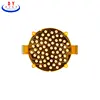Multi-Layerd Rigid-flex PCB Assembly -Leadsintec
Name: Multi-Layerd Rigid-flex PCB Assembly -Leadsintec
Origin: China
Certified: UL, CE, RoHS
Layer Count: 1 – 30 Layers
Surface Treatment: ENIG, Flash Gold, Hard Gold Finger, Gold Plating(50mil), Gold Finger, Selected Gold Plating, ENEPIG, ENIPIG
Board thickness: customized
Soldermask color: typically white, for aesthetic purposes
Surface finish: HASL/ lead-free HASL
What exactly does Multi-Layer Rigid-Flex PCB Assembly mean?
A printed circuit board (PCB) that incorporates rigid and flexible PCB materials is called a multi-layerd rigid-flex PCB assembly. It comprises several layers of stiff PCB parts joined by flexible PCB sections. It is possible to bend, fold, or twist rigid-flex PCBs to fit into small places or adapt to complicated form factors. Rigid-flex PCBs are made to combine mechanical stability and flexibility. While the flexible parts allow the board to flex and bend without breaking, the stiff sections provide structural support and serve as hosts for components.
The Assembly of Multi-Layer Rigid-Flex PCB by Leadsintec:
- Multi-layerd rigid-flex PCB assembly is a cutting-edge approach that combines the advantages of stiff and flexible printed circuit boards (PCBs) into a single, adaptable design is the rigid-flex PCB assembly. We can precisely translate your complicated and spatially limited electrical ideas into reality thanks to our sophisticated assembly skills. The intricate processes involved in rigid-flex PCB assembly are handled expertly by our knowledgeable specialists, who flawlessly combine stiff and flexible components to produce a robust and dependable circuit board.
- We have the knowledge to satisfy your unique needs, whether you need a multi-layered design or a PCB that is specifically designed to fit your needs. Rigid-Flex PCBs let you make the best use of the available space within your electrical gadgets. Compact designs are possible by doing away with the need for heavy connectors and wires, allowing for more streamlined and portable goods.
- Rigid-Flex PCBs are excellent for applications where durability is important since they are extremely resistant to mechanical stress, vibrations, and temperature fluctuations. The board’s overall dependability is increased by the incorporated flexible parts, which provide enhanced flexibility while lowering the possibility of solder joint fatigue.
Uses for Multi-Layer Rigid-Flex PCB Assembly:
Aerospace and defence:
Rigid-flex PCBs are frequently employed in these fields because of their propensity to tolerate abrasive conditions, vibrations, and spatial limits. They are employed in avionics systems, satellites, missile systems, and military hardware.
Medical Devices:
Where flexibility is needed yet space is at a premium in medical equipment, rigid-flex PCBs are used. They can be found in equipment, including pacemakers, hearing aids, medical imaging systems, and wearable health monitors.
Consumer electronics:
Various consumer electronics items, including computers and virtual reality headsets, employ rigid-flex PCBs. These PCBs make Compact and lightweight designs possible by offering dependable interconnectivity.
Automotive Industry:
Automotive electronics use rigid-flex PCBs because they can endure temperature changes, vibrations, and mechanical stress. They are used in projects like dashboard electronics, infotainment systems, engine control units (ECUs), and advanced driver assistance systems (ADAS).
Industrial Equipment:
Power distribution equipment, robots, industrial sensors, and rigid-flex PCBs are all examples of equipment utilized in the industrial sector. In abrasive industrial applications, they offer dependable and long-lasting connectivity.
Communication Systems:
Base stations, network switches, routers, and telecommunications equipment use rigid-flex PCBs. They provide for increased signal integrity, compact designs, and high-speed data transfer.
Internet of Things (IoT):
Compactness, flexibility, and dependable connectivity are crucial for IoT devices, which is why rigid-flex PCBs are used. They are utilized in wearable IoT devices, smart home appliances, and industrial IoT sensors.






